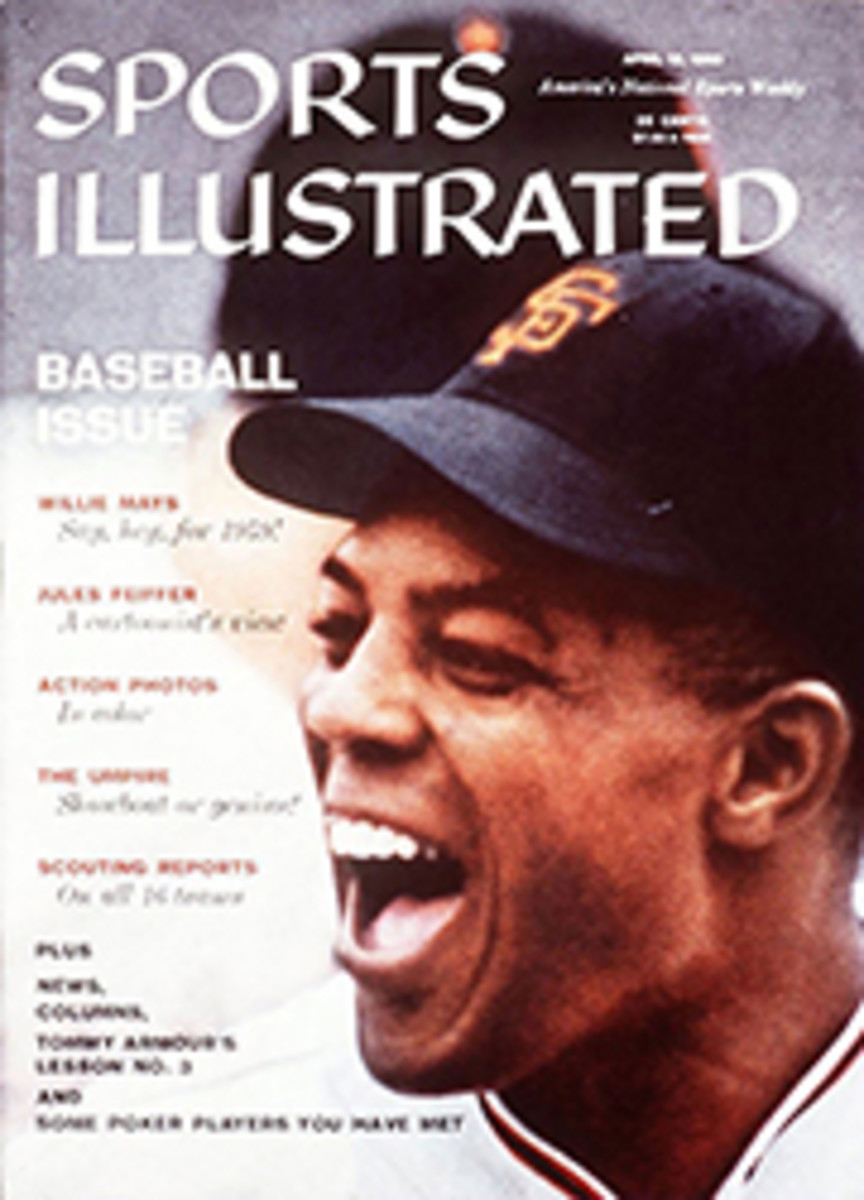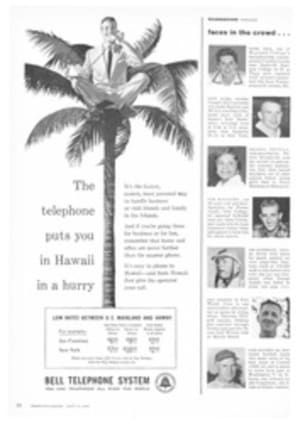
Ask Him Anything about Baseball
Lee Allen, a bald, roly-poly Cincinnatian, is, by his own admission, completely nuts about baseball. A loquacious raconteur endowed with total recall, he is able to talk for what seems almost ever about such long-forgotten players as Moses Solomon, "The Rabbi of Swat," a slugger the Giants brought up in the '20s to lure Jewish fans into the Polo Grounds, and one-armed Daily, a Cleveland pitcher back in the '80s who used to get into fights on the field and chop away at his adversaries with the stump of his left arm. Last month the officials of the National Baseball Hall of Fame and Museum in Cooperstown, N.Y. took note of Allen's mania and appointed him historian as of this April 15.
Now 44, Allen has been following baseball closely since he was 9. He is able to pinpoint the start of his obsession because, for some odd reason, a picture in the 1924 Spalding's Base Ball Guide, which shows Herb Pennock being struck in the small of the back during a run-down play, throbs hauntingly in his mind. By the time Allen was in high school, he had become so smitten with the game that his principal had no alternative but to grant him permission to play hooky on the days that the Reds were at home. "I just told him I couldn't go to class, and that we'd have to work something out," Allen recalls. "So we made a deal that I was to read Mark Sullivan's history, Our Times, and write a paper on it."
After graduating from Kenyon College, Allen enrolled at the Columbia School of Journalism only to leave suddenly in the middle of the spring term when Gabe Paul, then the publicity man and road secretary for the Reds, offered him a job as his assistant. Allen stayed with the Reds for two years, then embarked on a varied career as a newspaperman and sports announcer. All the while, however, he was accumulating books, manuscripts and marginalia on baseball, and from time to time he would burrow into the growing pile and emerge with a book of his own. So far he has written three, 100 Years of Baseball, The Cincinnati Reds and The Hot Stove League, all of which have met with impressive critical success.
As Allen sees it, his main duty at Cooperstown will be to answer questions from fans and writers, and to meet that end he already has several projects under way. For one, he is breaking down the number of games National League outfielders played in left, center and right fields respectively, an intellectual chore that is roughly as difficult as translating the collected works of Jack Woodford into Greek. "No one has ever separated outfields before," Allen said recently, popping up from behind the huge ledger in which he is entering his findings. "When Zack Wheat [the onetime Brooklyn outfielder] is inducted into the Hall of Fame this summer, I'll be able to tell him how many games he played in each field. Actually, he was pretty much of a left fielder all the time, but I'll be able to give the exact figure."
Another massive project of Allen's involves finding out where and when National Leaguers of the last century died. "My No. 1 quarry is Charles Wesley Jones of the Reds," he says. "In 1876 he led the team in home runs with four. He hit the first home run for Cincinnati in the National League, and he hit the first home run with the bases loaded for Cincinnati." Jones is something of a mystery, Allen explains, because "his name wasn't Jones but Rippay. Raised by an aunt in Princeton, Indiana, he adopted the name of Jones so she wouldn't know he was playing ball. His wife threw red pepper in his eyes, and that ended his career. So he became an umpire. Later he became a ward heeler for Tammany Hall, and he was known to be living on Staten Island in 1912. That's where the trail ends."
Generally, Allen finds his man. "There was a shortstop named Lewis Say with the Reds in 1880," he says, recalling a successful case with almost Holmesian satisfaction. "I happened to read a note in an old issue of the Sporting Life [a paper like The Sporting News that was published at the turn of the century] reporting that Say was living in Baltimore. So I wrote to H. L. Mencken, who was a Baltimore authority, and he said that the name rang a bell, but he didn't remember. He suggested that I write to the widow of an old Baltimore catcher who might know. I did. She wrote me a 16-page letter that was an attack on Franklin D. Roosevelt and didn't answer the question at all. So then I began all over. I wrote a letter to the editor of the Baltimore Sun, and I got a letter from a reader of The Sun in Fallston, Maryland, informing me that Mr. Say had died there in 1930 at the age of 76. I got his death certificate, and we were in business."
The curse of Allen's calling is the phony story accepted as true. One such story, given rather wide circulation by a sportscaster and printed in at least two books, had it that years ago a young Chicagoan who later became an official of the Missouri Pacific Railroad so idolized the White Stockings that he named nine Kansas way stations after his heroes when he grew up. The names of the players were Admire, Delavan, Helmick, Wilsey, Rapp, Miller, Allen, Bushong and Comiskey. Allen knew immediately that the story was false. In 1886, the Missouri Pacific first laid track in the part of Kansas in question, and at the time Comiskey was with the St. Louis Browns, not the Chicago White Stockings.
Another phony story, put out by the same sportscaster, had it that when William Howard Taft was a stripling the Red Stockings offered him a contract, and he would have signed it had not his father objected. "But, Dad," the sportscaster quoted Taft as saying, "this is major league baseball!" Instantly Allen demolished the story. First of all, the Red Stockings never signed players to contracts. Secondly, the team had disbanded by the time Taft was only 13. Lastly, the term major league had not been coined when the incident supposedly took place.
Allen also does what he can to knock down several harmless, but nonetheless false, stories that have sprung up over the years. One has it that Babe Ruth was an orphan. "His father lived to see him pitch for Boston," Allen says. Another has it that baseball expunged the names of the Black Sox from the records. "No such thing was ever done," he says. But the story that really irks Allen has to do with the assertion that the poem Casey at the Bat had a basis in fact. He points out that the author, the late Ernest L. Thayer, insisted that the poem was not inspired by any actual player, but to Allen's indignation that has not prevented several frauds from claiming to be Casey. One went so far as to make an appearance on the old radio show, We, the People, and Allen gets irritated just thinking about it now.
On occasion, Allen has put his encyclopedic mind to purely commercial use. A couple of years ago, he did a sort of reverse quiz show on a Cincinnati radio station. Listeners would name a major leaguer and ask Allen to identify his team and position. When Allen was stumped, the listener got the jackpot. "Once I went about 42 straight times without missing," he says. One player who stumped him was Ralph J. Miller, a third baseman for Philadelphia in 1920. Allen knew Miller was a third baseman, but he couldn't for the life of him place the team. "Gabe Paul said I should have known," Allen said ruefully not long ago.
A high moment in Allen's life came in 1949 when Jimmy Cannon, the sportswriter, got into an argument with Eddie Brannick, the Giants' road secretary. Cannon said Allen could talk longer about baseball than anyone he knew, but Brannick stuck up for Pat Monahan, a scout for the Chicago Cubs who had such a reputation for talking that it was once reported that Phil Wrigley, owner of the Cubs, ruled against his phoning scouting reports on the grounds the club couldn't afford the bill.
To settle the question once and for all, a friend of Allen's invited Monahan to Cincinnati to compete against Allen in a talkathon over a local television station. Allen and Monahan were to take turns answering questions phoned in by viewers, and the viewers would judge who talked longer. The match began at 8 in the evening and ended at 5 the next morning. It was apparent to all that Allen had won handily. Monahan himself sensed defeat coming early in the match. Along about 11 in the evening, he turned on Allen and snarled, "Ah, all you know about baseball is what you read in books."
At present, Allen is looking forward to the peace and quiet of Coopers-town. It doesn't bother him a bit that the nearest major league team is at least a five-hour drive away. "Watching baseball interferes with my study of baseball," he says.
PHOTO
HISTORIAN ALLEN AT WORK IN HIS BOOK-LINED LIBRARY
PHOTO
ABNER DOUBLEDAY FIELD, named after the man who did not father baseball, lies close to center of Cooperstown on Lake Otsego, is site of annual big league game.
PHOTO
PLAQUE at Cooperstown underscores major league backing of baseball shrine.

